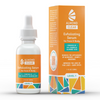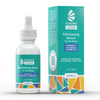What Does Fungal Acne Look Like and How to Treat It
Is that stubborn breakout not going away? There's a chance the breakout that you are treating as acne is actually fungal acne. Understanding what fungal acne looks like and how to effectively treat it can make all the difference in achieving clear and healthy skin.
What is Fungal Acne?


Examples of how fungal acne can look
Fungal acne, also known as pityrosporum folliculitis or Malassezia folliculitis, is a skin condition caused by an overgrowth of yeast (specifically Malassezia) in our hair follicles. It can appear as small, itchy bumps that resembles acne but are often more stubborn and resistant to traditional acne treatments.
Fungal acne is commonly found on the chest, back, shoulders, and the face. It requires a different approach for effective treatment compared to bacterial acne.
What Causes Fungal Acne?
Fungal acne is primarily caused by an overgrowth of Malassezia , which is a type of yeast that naturally resides on the skin's surface, but when it increases excessively, it can lead to fungal acne. Several factors contribute to the growth of Malassezia and the development of fungal acne:
1. Excess Sweat and Oil: Malassezia thrives in warm and humid environment which makes areas like the chest, back, and shoulders easy targets for fungal acne, especially during sweaty or oily conditions.
2. Skincare Products: Some skincare products, particularly those containing oils, fatty acids, or emollients, can worsen Malassezia and promote its growth. This includes moisturizers, makeup, and hair products that come into contact with the skin.
3. Certain Medications: Antibiotics and corticosteroids can disrupt the natural balance of microorganisms on the skin, potentially leading to Malassezia overgrowth.
What are The Symptoms of Fungal Acne?
Fungal acne typically appears as small, itchy, uniform bumps on the skin's surface, resembling acne but with some distinguishing characteristics. These bumps appear in clusters and can be red or flesh-colored while traditional acne is commonly associated with typical inflammation and pus-filled lesions.
Fungal acne affects areas prone to sweat and oil buildup, such as the chest, back, shoulders, and sometimes the forehead or hairline. Additionally, fungal acne tends to itch more than traditional acne due to the yeast involvement.
A difference from regular acne is the resistance to typical acne treatments. Fungal acne may worsen with topical acne medications containing benzoyl peroxide or salicylic acid, because it can further exacerbate the condition.
Fungal Acne Home Remedies
While home remedies can offer some relief for mild fungal acne, they are unlikely to fully resolve the condition or be effective on their own. Here are some at home remedies to treat fungal acne:
1. Maintain Good Hygiene: Keep the affected areas clean and dry. Shower regularly, especially after sweating, and change into clean clothes to minimize moisture buildup.
2. Use Dandruff Shampoo: Anti-dandruff shampoos containing ingredients like ketoconazole or selenium sulfide can help reduce Malassezia yeast on the skin. Use as directed on affected areas, such as the chest or back, and leave on for a few minutes before rinsing off.
3. Wear Loose Clothing: Breathable, loose-fitting clothing allows airflow and reduces friction on affected areas, which can help prevent further irritation.
When Should I See A Doctor?
It's important to seek medical attention from a doctor or dermatologist under certain circumstances related to fungal acne:
1. Severe Breakouts: If you experience severe or widespread fungal acne breakouts that are causing significant discomfort or itching consider consulting a healthcare professional.
2. Lack of Improvement with Home Remedies: If home remedies and over-the-counter treatments do not show improvement or if the condition continues, a doctor's consultation is necessary to explore other options.
3. Concerns About Specific Products: If you have concerns about using certain skincare products, such as those that could possibly worsen fungal acne or cause skin irritation, a dermatologist can provide guidance.
4. Underlying Health Conditions: People with compromised immune systems or other underlying health conditions that may cause fungal acne should consult a doctor for appropriate management and monitoring.
Fungal Acne Diagnosis
Diagnosing fungal acne typically involves a combination of clinical assessment and sometimes laboratory testing. During a physical examination, a dermatologist will evaluate the appearance of the skin and the distribution of lesions characteristic of fungal acne.
In some cases, a dermatologist may perform a skin scraping or skin biopsy to test the presence of Malassezia yeast. This involves gently scraping the area to obtain a sample for microscopic examination.
How is Fungal Acne Treated by a Doctor?
Here are common treatments prescribed by doctors for fungal acne:
1. Topical Antifungal Medications: Prescription-strength antifungal creams, lotions, or gels containing ingredients like ketoconazole, ciclopirox, or econazole may be applied directly to the affected areas. These medications help eliminate Malassezia yeast and reduce inflammation associated with fungal acne.
2. Oral Antifungal Medications: In severe cases or when topical treatments are not enough to treat , oral antifungal medications such as fluconazole or itraconazole may be prescribed.
3. Medicated Shampoos: For fungal acne affecting the scalp or hairline, doctors may recommend using medicated shampoos containing ketoconazole or selenium sulfide to reduce yeast presence and prevent recurrence.
4. Adjusting Skincare Routine: Doctors may recommend using fungal acne-safe skincare products and maintaining good hygiene practices that are important components of treatment.
5. Lifestyle Modifications: Lifestyle changes such as wearing breathable clothing, managing excess sweat, and maintaining overall skin hygiene can help prevent fungal acne.
Do Regular Anti-Acne Treatments Cure Fungal Acne?
Regular anti-acne treatments designed for bacterial acne, like benzoyl peroxide or salicylic acid, are not effective against fungal acne caused by Malassezia yeast. These products do not target yeast overgrowth and may even worsen fungal acne by disrupting the skin's microbiome and promoting yeast growth.
Non-Acne Treatments That Can Treat Fungal Acne
These skincare products can complement anti-fungal treatments by maintaining skin health and reducing irritation without interfering with the efficacy of fungal acne medications. While traditional acne products should be avoided due to their potential to worsen fungal acne, here are some non-acne skincare products :
1. Gentle Cleansers: Use gentle, non-comedogenic cleansers formulated for sensitive skin to cleanse affected areas without stripping the skin's natural moisture barrier. Avoid harsh cleansers that can further irritate fungal acne-prone skin.
2. Non-comedogenic Moisturizers: Lightweight, oil-free moisturizers can hydrate the skin without adding excess oils or ingredients that can feed Malassezia yeast. Look for moisturizers labeled as fungal acne-safe or non-comedogenic.
3. Tea Tree Oil: Tea tree oil has natural antifungal properties and may help alleviate symptoms when used in diluted form. Apply a small amount to affected areas after patch testing.
4. Aloe Vera Gel : Aloe vera gel has soothing properties that can help calm irritated skin and reduce inflammation associated with fungal acne. Use pure aloe vera gel without added ingredients that may exacerbate fungal acne.
Are There Any Side Effects of Fungal Acne Treatment?
Antifungal medications used to treat fungal acne, like ketoconazole or ciclopirox, may cause side effects such as skin irritation, dryness, or allergic reactions. Oral antifungal medications can also have side effects like gastrointestinal upset or liver toxicity, requiring close monitoring by a healthcare professional. Notify your doctor if you experience any unusual symptoms or reactions while using antifungal medications.
Is Fungal Acne Contagious?
Fungal acne is not contagious and is not transmitted from person to person like infectious diseases or bacterial infections. It is not spread through direct contact with affected individuals or through sharing personal items like towels or clothing.
Recommended Products for Fungal Acne
A gentle but powerful skin ingredient to consider when treating fungal acne is mandelic acid. Mandelic acid is a type of alpha hydroxy acid (AHA) derived from bitter almonds known for its exfoliating and skin-brightening properties.
Almond Clear is the only skincare brand powered entirely by mandelic acid. Their natural, minimal formulation have become staples in many people’s routines. Almond Clear products have helped thousands of people to clear fungal acne and other skin concerns. Here’s a brief look at the product line :
Face and Body Wash : This gentle cleanser has 2% mandelic acid and soothing botanical extracts. It gently exfoliates the skin, improving a variety of skin concerns. It can be used on both the face and body, making it versatile in tackling problem areas from head to toe.
Level 1 Exfoliating Serum : This exfoliating serum is powered by 10% mandelic acid and is formulated for the face or sensitive body skin. It improves all types of blemishes, hyperpigmentation, dark spots, fine lines, sagging skin, and dark scars.
Level 2 Exfoliating Serum: This exfoliating serum contains 15% mandelic acid and is formulated for use on the body. It improves acne, folliculitis, and is also effective in removing hyperpigmentation, dark spots, and scars. This top-selling product has helped thousands of people to clear butt acne, body acne, folliculitis, and more.
2-in-1 Hydrating Gel : This 2-in-1, ultra-lightweight gel is way more than just a moisturizer; it's also supercharged with natural ingredients that go beyond hydrating the skin. It’s great for users with oily skin and has a low percentage of mandelic acid that helps fight breakouts, reduce pore size and keep your skin nourished.
Soothing Daily Moisturizer: This creamy, lightweight moisturizer is incredibly hydrating and soothing. It is non-comedogenic and works great at maintaining and repairing the skin’s protective barrier after exfoliating. It has natural and calming ingredients like aloe vera, squalane and hyaluronic acid.








